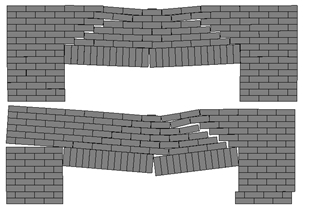Stochastic strength prediction of masonry structures: a methodological approach or a way forward?
DOI:
https://doi.org/10.21809/rilemtechlett.2019.100Keywords:
masonry, material, numerical modelling, monte-carlo simulations, discrete element methodAbstract
Today, there are several computational models to predict the mechanical behaviour of masonry structures subjected to external loading. Such models require the input of material parameters to describe the mechanical behaviour and strength of masonry constructions. Although such masonry material parameters are characterised by stochastic-probabilistic nature, engineers are assigning the same material properties throughout the structure to be analysed. The aim of this paper is to propose a methodology which considers material spatial variability and stochastic strength prediction for masonry structures. The methodology is illustrated on a case study covering the in-plane behaviour of a low bond strength masonry wall panel containing an opening. A 2D non-linear computational model based on the Discrete Element Method (DEM) is used. The computational results are compared against those obtained from the experimental findings in terms of failure mode and structural capacity. It is shown that computational models which consider the spatial variability of masonry material properties better predict the load carrying capacity, stiffness and failure mode of the masonry structures. These observations provide new insights into structural behaviour of masonry constructions and lead to suggestions for improving assessment techniques for masonry structures.

Downloads
Published
How to Cite
Issue
Section
License
Authors retain copyright of the articles published in RILEM Technical Letters and grant the journal the right of first publication with open access. The work is simultaneously licensed under Creative Commons Attribution 4.0 International License (CC BY 4.0) that allows others to share and adapt the work under the following terms: 1) a proper attribution is given in a form of a reference to the original work's authorship and initial publication in RILEM Technical Letters (bibliographic record with the DOI link); 2) a link to the license is provided; 3) the changes (if any) are indicated.









